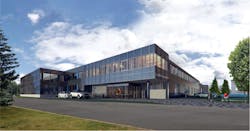With the Support of the Cohesion Fund Riga Airport, Technical Services Building to be Reconstructed
Riga Airport and “RERE Meistari Ltd.” have signed a contract for the reconstruction of the airport's technical services building. During the renovation, around 6000 m2 of space will be insulated, while 4000 m2 will be completely rebuilt to provide working space for the airport's support services.
“The reconstruction will provide our employees with modern working premises and will solve the issues of environmental accessibility, as well as it will allow us to use our resources more optimally and increase the energy efficiency class of the building, which is an important step towards the goals of the airport's sustainability strategy,” said Laila Odiņa, Chairperson of the Board of Riga Airport.
Edgars Vēveris, representative of the general contractor, member of the board of JSC “RERE Grup”, states, “The construction project includes not only the reconstruction of the technical services building, but also the construction of engineering networks, environmental accessibility solutions and landscaping works. The project will improve the energy efficiency and ergonomics of the technical services building, which will reduce energy consumption and accommodation costs in the long term, as well as allowing technical staff to perform their work more efficiently.”
The budget for the redevelopment is € 9.6 million, of which 83 % will be covered by the Airport's own investment budget and 17 % by the EU Cohesion Fund. The contract with the builder provides for work to start in July this year and be completed by the end of 2023.
The reconstruction of the technical services building, built in the 1970s, is one of the activities supported by the Cohesion Fund-funded project “Development of Safe and Environmentally Friendly Infrastructure at Riga International Airport”. As part of the project, Riga Airport is carrying out major infrastructure development works on the airfield and the airport area. The airport has built a second taxiway to help reduce CO2 emissions, installed axis lights on taxiways as a first step towards the airport's innovative “follow the greens” aircraft management system, and built a landing area for emergency medical services and aviation search and rescue, as well as military, national government and other helicopters. The CF also supported the reconstruction of the access roads to the public part of the airport, the modernization of the storm water drainage system and the lighting infrastructure.



